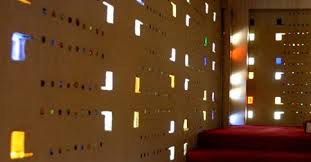“Study nature, love nature, stay close to nature. It will never fail you.” – Frank Lloyd Wright
With these words said, I do think Lloyd Wright would approve of measures taken, using the innovation and art of 3D printing to reverse nature, in the name of preserving part of his iconic architectural legacy at Child of the Sun—also known as Florida Southern College, Lakeland, Florida.
Despite Lloyd Wright’s painstaking design work for the campus–and not unimpressive, heavy contribution of student labor between 1938-1941, Mother Nature and Father Time took a toll on the largest architectural enclave of Frank Lloyd Wright’s work at Florida Southern College. Greatly deteriorated were the 6,000 tapestry blocks at the Annie Pfeiffer Chapel, which was the first structure (of twelve) that he designed on the Florida Southern campus in 1941, and has been part of the ongoing restoration.
After a long period of time where Lloyd Wright’s largest work of structures needed restoration but it was not cost-effective to do so, the Florida Division of Historical Resources allocated a number of grants to preserve the campus, and a $50,000 grant toward restoring the thousands of signature Wright-designed cement blocks in the grand chapel.
The concrete block structure patterns he was fond of using in many of his works has been high-maintenance and problematic to preserve—until now, with the introduction of 3D printing into the restoration process. 3D printers were able to replicate and restore a portion of the architecture, while keeping the budget down substantially—overcoming the previous financial hurdle for the project.
In the hands of architect Jeff Baker of Mesick Cohen Wilson Baker Architects, the project took one year. Baker supervised the restoration of Lloyd Wright’s cement block structures turning to the aid of 3D printers to replicate and replace what was once a tedious manual process. Using the Makerbot Replicator and the Rostock Max V2 to print fingers for the molds of the blocks, they were able to insert 2,000 colored glass tiles into the original blocks, restoring the original jeweled box effect.
“The success found on this project is a milestone not only in the restoration of Frank Lloyd Wright buildings on the FSC campus but also for similar textile block projects designed by Wright and other architects throughout the nation,” said Jeff Baker.
The Annie Pfeiffer Chapel is just one part of the restoration process as the entire campus, has fallen victim to complications from moisture and the elements. Designed solely by Frank Lloyd Wright, on the heels of the depression, while he was actually at the height of his career, the campus was meant to encompass his organic concept, bringing students together with their environment, thus providing them with an overall sense of peace to work together as a harmonious group.
The campus was named to the World Monument Fund’s 100 Most Endangered Sites in 2007. As restoration efforts continue to go forth, the world watches as the Sunshine State works to protect Wright’s largest collection of buildings in one place. Discuss this impressive use of 3D printing, in the Lloyd Wright building restoration forum thread on 3DPB.com.
[Image Source: Design-Milk]Subscribe to Our Email Newsletter
Stay up-to-date on all the latest news from the 3D printing industry and receive information and offers from third party vendors.
Print Services
Upload your 3D Models and get them printed quickly and efficiently.
You May Also Like
This Year’s Forbes 30 Under 30 Innovators Pushing 3D Printing Into the List
For 15 years, the Forbes 30 Under 30 North America list has highlighted young people who are reshaping industries across the U.S. and Canada. This year, a few innovators stand...
UK’s Base Materials Launches Large-Format 3D Printing Service
Tooling has been one of the additive manufacturing (AM) industry’s biggest success stories for quite some time, but the market is still in its early phases. One factor giving this...
Formnext 2025: New Metal PBF 3D Printer, Serial Production Applications, & More
It’s Day 2 of Formnext 2025, where over 800 exhibitors from around the world have converged in Frankfurt for Europe’s premier additive manufacturing (AM) trade show. From exciting new printers...
Indian Additive Construction Firm MiCoB Delivers Over 500 Bunkers to the Indian Army
Like many nations attempting to capture Industry 4.0 gains, India laid out an ambitious long-term plan in 2014 to transform its economy: the Make in India initiative. However, as is...



































